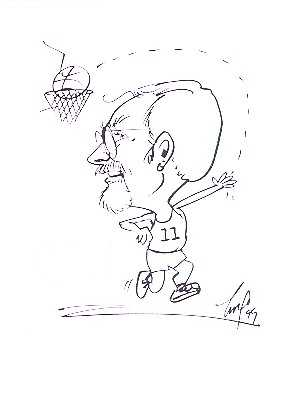BAFFLE and ROAR
Bad news in the local paper Friday about last Tuesday's Town election; the ballot measure that would have funded several new playing fields and tennis courts (and in the process converted the old tennis courts across the street from me into two new outdoor basketball courts) failed to win passage. The difference between the Yeas and the Nays was only 11 votes, (which means that a swing of only six voters would have resolved the issue the other way). Naturally, a recount is in the offing...and I remain optimistic that we will still see some variation of this proposal again at a future election if the recount fails to change the outcome. Still, it's a disappointment. I was looking forward to playing on those courts sooner rather than later.
Meanwhile, my shooting woes continue -- once again shot 0-fer ballgame last night, and to make matters worse my "D" was crap too. But what the heck...it's just a game....
****
When I was coaching at the Boys & Girls Club on Nantucket, I tried to come up with acronyms that would help my players learn some of the basic principles I wanted them to play by. For the half-court game it was BAFFLE: BALANCE the floor ATTACK the basket: FILL back to the ball; FAKE out your opponent; LOOK for the open man; EXECUTE the EXTRA pass to EARN an EASY BASKET. For the fast break it was ROAR: REBOUND the ball; OUTLET quickly; ATTACK (we do a lot of attacking in my offensive schemes) down the middle; RUN the floor and fill the lanes.
Floor Balance is (or should be) a relatively easy concept. There are basically 11 prime scoring spots on the floor: the point, the wings, the corners (all of which potentially take advantage of the three-point line), the elbows (the corners formed by each end of the foul line and the sides of the lane), the blocks, right at the rim (generally known as "In the Paint") and at the "Charity Stripe" or free throw line. Pick-up ballers don't really need to worry about this last (since the only time we tend to shoot free throws is to get into a game in the first place), and in a lot of places each score only counts for one point anyway. But the basic idea is NEVER HAVE TWO OFFENSIVE PLAYERS STANDING IN THE SAME SPOT AT THE SAME TIME! You would be surprised how difficult this is to achieve sometimes, which brings me to the next topic...
Attack the Basket/Fill Back to the Ball. Not only is the basic idea to Balance the Floor, the IDEAL is that no one should EVER be standing still. The fundamental principle of movement is simple: pass the ball to a teammate and cut to the basket, thus executing the old-fashioned give-and-go. As the spot you just left becomes empty, a teammate should fill it by coming back to the ball (or, more accurately, to the now-vacant spot one pass away from where the ball is now). An alternative is to pass the ball and then screen away for a teammate, who attacks the basket instead. But the point is not to crowd the ballhandler, while at the same time forcing the defenders to move their feet to defend the basket, and giving the ballhandler a easy replacement/outlet if the return pass to the cutter (or a strong drive to the basket) isn't open.
Fake out your Opponent. If the defenders can anticipate where the ball is going to be passed, they are in a much better position to defend against it. So it's important that the ballhandler's teammates give him plenty of options, and that the ballhander avoids "telegraphing" his passes. Just remember, the point is to fake out your opponents, NOT your teammates!
Look for the Open Man and Execute the Extra Pass to Earn an Easy Basket. Your opponents can't be everywhere at once. As players move and share the ball eventually somebody is going to be left alone without a defender. Find him and get him the ball! There is always, Always, ALWAYS a good, wide-open shot three good passes away....
That is the BAFFLE part of the program. ROAR is even easier.
REBOUND the ball. You can't run without it. The art of rebounding is a topic for another day, but all offense begins with gaining possession of the ball.
OUTLET quickly. This is probably the most important factor in a successful running game. You want to get the ball out from underneath your opponent's goal and headed toward your own as quickly as possible.
ATTACK down the middle. This forces your opponents to defend the basket AND both sides of the court at once.
RUN the floor and fill the lanes. Ideally, the ballhandler should attack down the middle, with potential cutters on both sides of him, a fourth player trailing the play for a pull-up jump-shot or a second attack off the dribble, and the second trailer (usually a big man, and often the original rebounder) ready to finish late and hard, straight down the center of the lane at the rim.
What people often forget is that good running teams who share the ball well don't have to beat ALL of the defenders back to the basket; they just have to beat ONE of them. Likewise, the transition from ROAR to BAFFLE ought to be seamless; if the lay-up isn't there just balance the floor and keep passing and attacking until it is.
But the best thing about his sort of "system" is that it's organic -- there's nothing complicated to learn or practice or remember. Which makes it perfect for pick-up games. Learn it yourself, and then teach it "by precept and example" to the guys you play with regularly. But that's a topic for another day as well.


0 Comments:
Post a Comment
<< Home